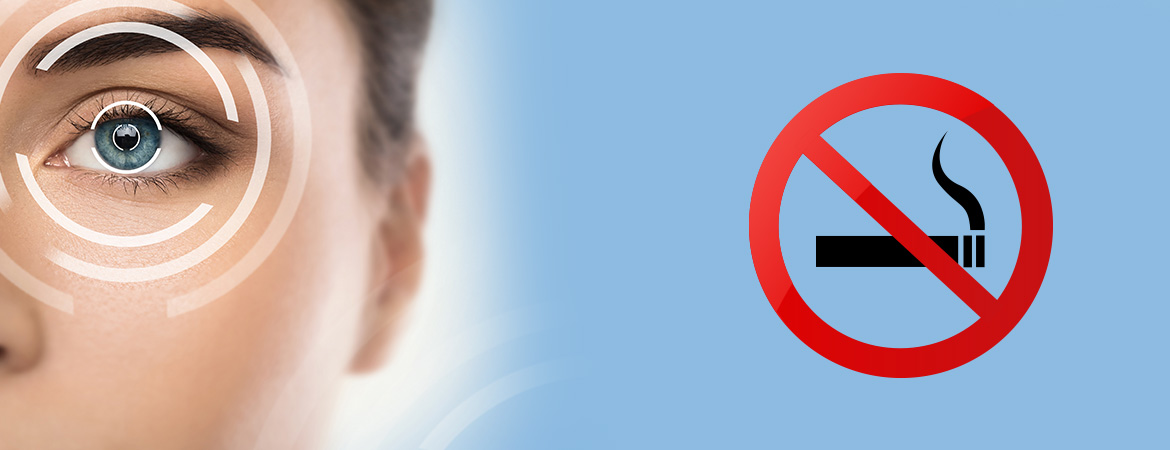Cigarette Smoking and Retinal Carotenoids
Smoking Hazards
Smoking cigarettes contributes to the development of numerous chronic diseases.
One important deleterious effect of smoking may be increased oxidative stress on tissues. Increased oxidative stress due to smoking has already been implicated as a causal factor in the pathogenesis of some smoking-related illnesses, such as atherosclerosis, nuclear cataract, and proliferative diabetic retinopathy.
We are concerned with age-related macular degeneration, a chronic retinal disease that may reflect accumulated oxidative damage. Cigarette smoking dramatically increases the risk of neovascular AMD. The increased risk may be due to numerous pro-oxidants shown to be present in cigarette smoke (Pryor and Stone, 1993; Church and Pryor, 1985).
These pro-oxidants are toxic to many cellular components, particularly lipid membranes (Niki et al.,) and have been shown to increase lipid oxidation in vivo and in vitro.
These effects may be produced either directly by material in the cigarette smoke, or indirectly by lowering antioxidant defenses and increasing the vulnerability of smokers to oxidative damage from other environmental agents (e.g., light exposure; Snodderly).
Epidemiologic studies have shown that carotenoids (pigments found in many fruits and vegetables) in the blood, and the specific carotenoids lutein and zeaxanthin in the diet, are protective against the neovascular form of AMD.
These two carotenoids are accumulated by the retina in the foveal region and form the yellow macular pigment that gives the region its name, the macula lutea. Several lines of evidence suggest that macular pigment may protect the retina and retinal pigment epitheliums from damage.
Consequently, low levels of macular pigment may contribute to an increased risk of developing AMD for smokers. Lower levels of retinal carotenoids would be consistent with the lower blood levels of carotenoids found in smokers. It is known that smokers have lower concentrations of carotenoids in their blood even after adjusting for differences in dietary intake.
Data from studies that have used in vivo and in vitro techniques have shown that inter-individual variation in macular pigment density is high. We now report that cigarette smoking is one major factor. This is the first report we are aware of showing a relationship between smoking and tissue (as distinguished from blood) carotenoid concentrations.
Smokers and nonsmokers were matched carefully in order to minimize any lifestyle differences that might exist between the two groups. The selection of these variables was based on recent studies identifying factors related to individual differences in MP density and risk of AMD.
Controls were also matched on dietary variables including carotenoid intake, dietary fat and iron. Dietary variables were selected based on past studies on factors that affect carotenoid metabolism and MP density. Malinowet al. showed that monkeys maintained on carotenoid-free diets lacked MP, showing that MP is derived from the diet rather than synthesized de novo.
Dietary fat was analyzed because Dimitrov et al. and Prince and Frisoli have shown that some dietary fat is necessary to absorb carotenes into the blood. L and Z are lipid-soluble and dietary fat may facilitate proper absorption through the gut. The main finding in the present study is a significantly lower MP density in smokers compared to nonsmoking matched controls. 63% of smokers had virtually no MP compared to 21% of the matched controls.
These data show that smokers have significantly reduced MP density and this difference is not due to differences in dietary carotenoid intake. Smoking frequency (cigarettes per day) was inversely related to MP density. This reduction may be an indirect result of lower carotenoid concentrations in the blood and/or a direct effect on the retina.
Evidence is mounting that smoking lowers antioxidant protection available to tissues throughout the body. For example, decreased concentrations of antioxidant enzymes have been reported in the alveolar macrophages and erythrocytes of smokers. Male smokers also have reduced concentrations of vitamins E and C in the arterial tissue of their internal mammary artery.
The effects of smoking on tissue antioxidant concentrations may be one of the mechanisms through which smoking predisposes smokers to tobacco-associated illnesses.
The effect of smoking on the retina is particularly devastating, since it markedly increases the risk of blindness due to the neovascular form of AMD. Fortunately, carotenoids in the blood (Eye Disease Case–ControlStudyGroup 1992,1993) and diet have been associated with a decreased risk of neovascular AMD. At the presenttime there is no way to distinguishwhether carotenoidsin the blood are protecting the retina indirectly,or whether they simply serve as markers for differences in retinal carotenoids. The available evidence suggests that MP carotenoids in the retina have specific protective effects.
Light exposure and high lipid content may make retinal cells particularly prone to oxidative insult.
Oxidative damage has been implicated as a causal factor in the angiogenesis of subretinal neovascularization.
Thus, one mechanism through which smoking might increase the probability of developing neovascular AMD is by causing oxidative stress to the retina that exceeds protection by MP and other protective factors. Although the health consequences of smoking seem clear, it remains difficult for many individuals to quit smoking. This raises the question of whether nutritional strategies can be developed to reduce the deleterious effects for those who simply cannot break the habit.
A modifying effect of high carotenoid intake was also reported by Seddon et al. In their study, smokers with very high intake of lutein and zeaxanthin did not have an increased risk of AMD, as did smokers with moderate or low intake of lutein and zeaxanthin.
The combination of evidence suggests that smoking-induced reduction of retinal carotenoids might be at least partially offset by compensatory diet strategies. High intake of foods rich in carotenoids and antioxidant vitamins might help some hopelessly addicted smokers become less susceptible to tobacco associated diseases.

